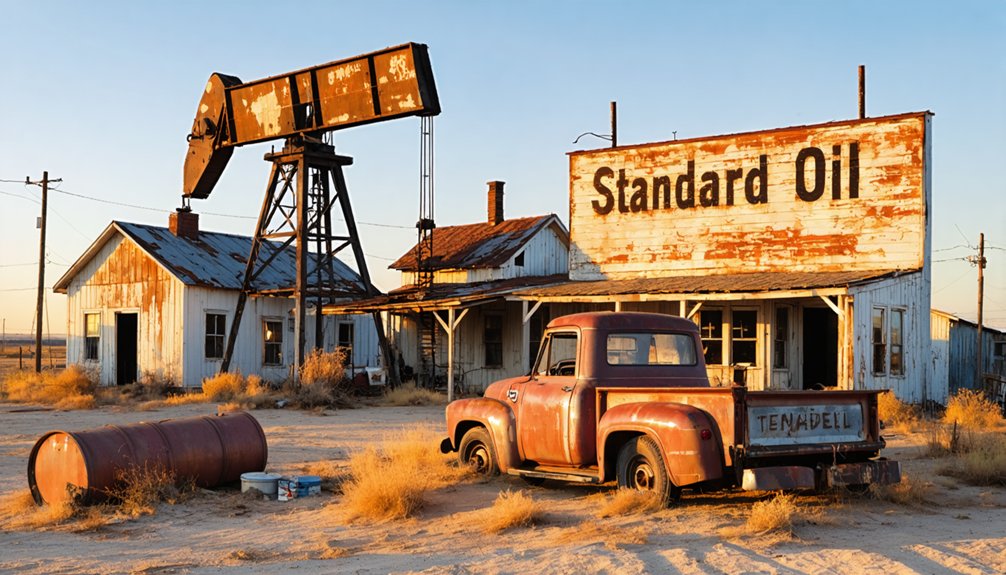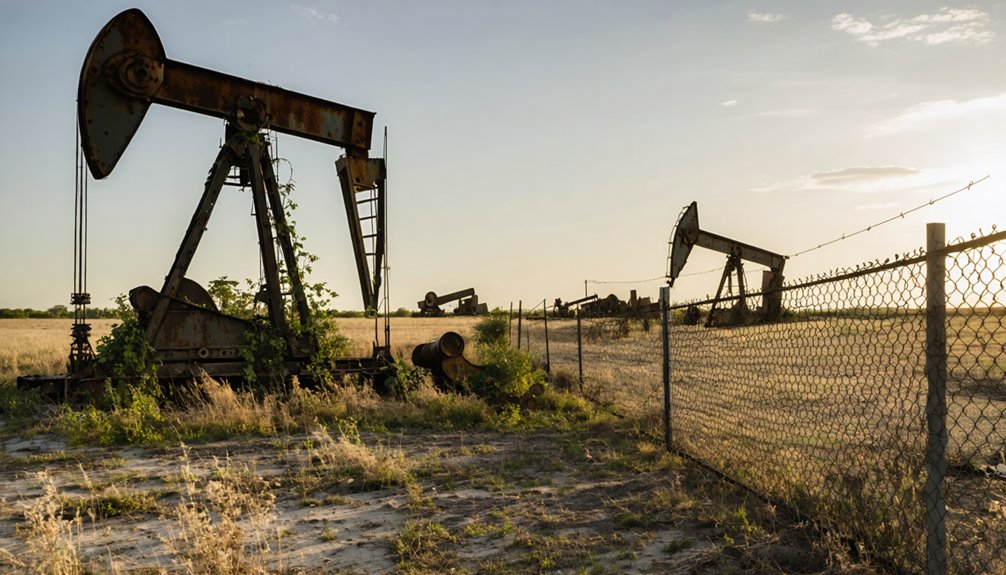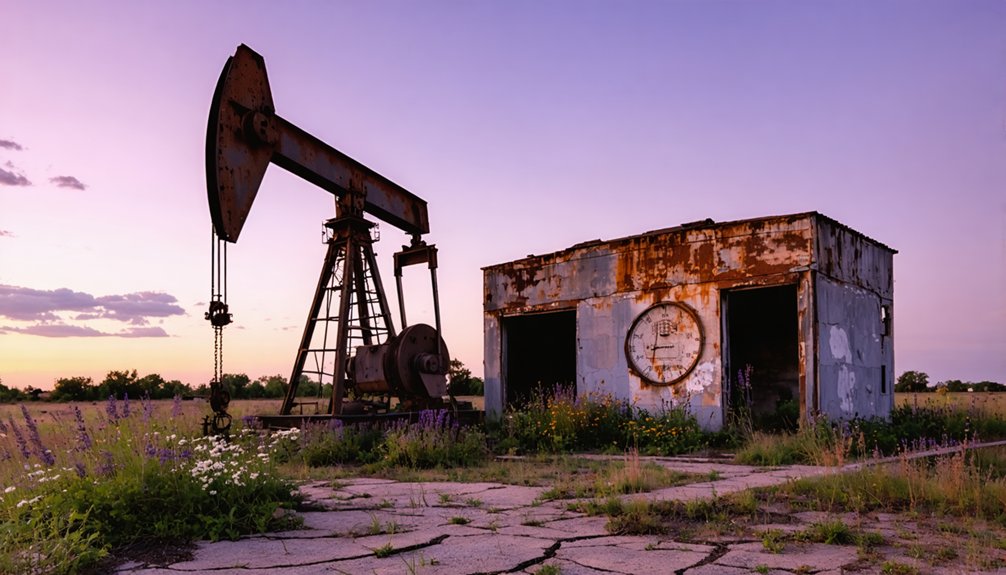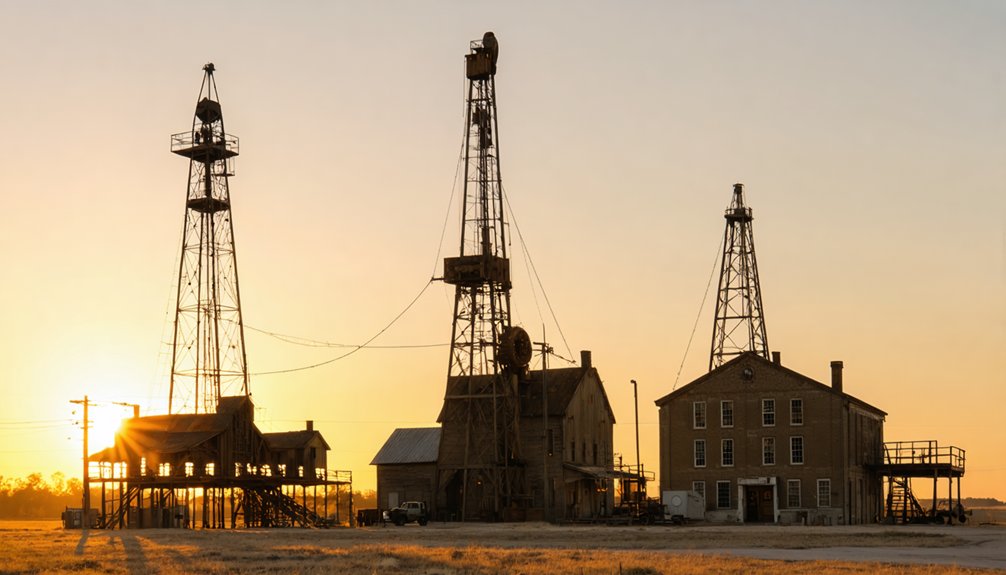America’s abandoned oil towns offer a haunting glimpse into boom-bust cycles that shaped the nation. You’ll discover ghost towns like Glenrio with its rusted Texaco stations and Pithole’s remnants where 15,000 people once thrived. These forgotten landscapes now reveal environmental hazards—over 120,000 orphaned wells leaking toxins into groundwater systems. From Pennsylvania’s wooden casings to the Permian Basin’s vacant infrastructure, each crumbling facade tells a story of fleeting prosperity and lasting consequences.
Key Takeaways
- Abandoned oil towns like Pithole, Pennsylvania showcase boom-bust cycles where populations soared to 15,000 before rapid decline.
- Over 400 ghost towns in New Mexico feature abandoned motels, rusted gas stations, and vacant buildings from former oil prosperity.
- The Permian Basin contains more than 100,000 abandoned wells presenting environmental hazards like sinkholes and toxic gas emissions.
- Historical preservation efforts compete with environmental remediation needs, requiring $4.7 billion in federal infrastructure funding.
- Former boomtowns face declining tourism, shuttered businesses, and economic reinvention challenges while maintaining their industrial heritage.
The Birth and Death of Black Gold Communities

When the first oil well gushed forth in places like Pithole, Pennsylvania in 1859, it triggered not just an industrial revolution but a human one as well.
Within months, these empty landscapes transformed into bustling communities of 15,000 souls, many of them war veterans seeking fortune in America’s new frontier. The revolutionary Van Syckel pipeline, established in 1865, transported 80 barrels of oil per hour and eliminated the need for 300 teamster wagons. The oil industry dynamics created instant infrastructure—57 hotels, Pennsylvania’s third busiest post office, and essential services materialized almost overnight.
But these towns lived and died by the black gold beneath them. When wells ran dry or richer fields were discovered elsewhere, capital and workers fled just as quickly as they’d arrived. Similar to the Texas town of Ranger, whose population surged to 30,000 during the 1917-1921 oil boom before dramatically declining.
Community resilience was tested as fires, economic downturns, and resource depletion hollowed out once-thriving streets, leaving behind only wooden skeletons and rusting equipment as evidence to their fleeting glory.
Ghost Towns of the Permian Basin
As you traverse the sun-baked expanse of the Permian Basin, you’ll encounter the skeletal remains of towns like Glenrio, where abandoned State Line Motels and rusted Texaco stations stand as monuments to the region’s boom-and-bust oil legacy.
These corporate-built communities once bustled with roughnecks and railroad workers before global oil gluts and transportation shifts transformed them into wind-swept ghost towns with derelict infrastructure. Many visitors are fascinated to learn that New Mexico boasts over 400 ghost towns across its diverse landscapes.
Glenrio’s unique position on the Texas-New Mexico border created unusual customs where mail was transported from the Texas train depot to the New Mexico post office.
What remains now—crumbling motels, empty diners, and weathered oil wellheads scattered across West Texas and southeastern New Mexico—tells the poignant story of America’s forgotten frontier industrial age.
Boom-Bust Legacy Lives
Though decades have passed since the great oil collapses of the 1980s, the boom-bust legacy remains etched into the landscape of the Permian Basin like geological strata.
You’ll discover vacant buildings standing as silent witnesses to fortunes made and lost—testaments to an oil heritage that transformed ranching communities into boomtowns overnight.
Walk through Midland and you’ll sense the ghosts of the 1986 crash when foreclosures swept through neighborhoods that once boasted luxury cars in every driveway.
Yet community resilience prevails. Since 2000, hydraulic fracturing and horizontal drilling have breathed new life into these weathered towns, with Midland now ranked among America’s fastest-growing communities.
The historic Santa Rita well, first Permian producer in 1923, marked the beginning of the region’s complicated relationship with petroleum prosperity and decline.
Unlike previous cycles, today’s revival shows more staying power, bolstered by expanded infrastructure and global export markets that weren’t available before.
The discovery at Santa Rita No. 1 unveiled an astounding 75,000 square miles of previously untapped petroleum reserves that would forever change the economic landscape of West Texas.
Desolate Infrastructure Remains
Across the desolate stretches of the Permian Basin, over 100,000 abandoned oil and gas wells punctuate the landscape like industrial gravestones, leaking silent poisons into the soil and water.
You’ll find the highest concentration in Pecos County—more than 600 orphaned wells—with Frio, Reeves, and Crockett counties following closely behind.
Drive through these desolate landscapes and you’ll witness the haunting remnants of boom times: sinkholes capable of swallowing four-story buildings, toxic sulfuric lakes, and abandoned infrastructure threatening entire highways.
The Kelton Ranch well, supposedly secured in 1977, created a 200-foot crater in the earth.
Downtown Odessa stands eerily vacant, its economic activity pushed to the outskirts in a donut-shaped pattern—a physical manifestation of the industry’s fickle nature and the freedom it promised but rarely delivered. This pattern reflects aging infrastructure challenges that plague many oil boom towns, where rapid population growth historically outpaced sustainable development.
These abandoned wells continuously emit poisonous hydrogen sulfide gas, creating serious health hazards for nearby communities and ranchers who work the surrounding land.
Forgotten Corporate Towns
When petroleum giants like Humble Oil planted their corporate flags in the Permian Basin during the 1920s, they didn’t just drill wells—they created entire communities from scratch.
These corporate ghosttowns now stand as forgotten legacies of America’s oil rush era.
McCamey’s company camp bloomed around Humble Oil’s refinery, while Big Lake emerged as the Permian’s first true oil town following Santa Rita No. 1’s success.
These towns followed predictable lifecycle patterns:
- Rapid construction of infrastructure and worker housing
- Brief period of prosperity during peak production years
- Eventual abandonment as corporations moved operations elsewhere
You’ll find Wink’s empty urban renewal plots and Imperial’s environmental scars particularly telling.
Even Odessa, still populated, bears the hollow core of downtown vacancy—a reflection of the boom-and-bust rhythm that defines these petroleum-built communities.
The Kelton Ranch near McCamey directly connects to this history, purchased in 1963 amid the remnants of the oil boom that began after George McCamey’s 1925 discovery.
Following Santa Rita No. 1’s drilling that took an arduous 21 months at less than five feet per day, many similar ghost towns struggled with the slow pace of development before their eventual abandonment.
Walking Through Time: Route 66’s Abandoned Oil Outposts
As you journey along the faded remains of America’s most iconic highway, Route 66‘s abandoned oil outposts stand as haunting symbols to boom-and-bust cycles that defined America’s 20th century growth.
Towns like Depew and Shamrock once thrived when black gold erupted from the earth, their abandoned architecture now telling historical narratives of prosperity and loss.
You’ll find Alanreed’s desolate landscape particularly striking—once a bustling Panhandle oil hub with just 52 residents remaining by 2001.
The dual blows of Interstate I-40’s construction and oil depletion delivered what locals call “the final nail in the coffin” for these communities.
In Depew, original Route 66 concrete still runs down Main Street where the Coppedge Drug Store stands empty, a time capsule from when these towns weren’t just places—they were promises.
Environmental Scars: The Legacy of Forgotten Wells

As you wander among these ghostly oil towns, you’re actually walking above an invisible network of over 120,000 documented orphaned wells leaking methane and toxic chemicals into groundwater that 4.6 million Americans live near.
You’ll notice few signs of the underground crisis where unplugged wells silently contaminate water supplies, sometimes mobilizing arsenic and creating explosion hazards in nearby buildings.
The $75,000-per-well cleanup cost has created a devastating financial shortfall, with federal remediation funding falling short by 30-80% of the estimated $4.7 billion needed to address these toxic time bombs beneath your feet.
Leaking Toxic Time Bombs
The rusting metal skeletons of America’s forgotten oil wells dot the landscape like environmental landmines, quietly leaking their toxic contents into soil, water, and air. As you wander these abandoned oil towns, you’re breathing toxic emissions from orphaned wells that contain methane with 80-84 times the warming potential of carbon dioxide over two decades.
Lake Boehmer in West Texas stands as a symbol of this contamination, where:
- Up to 600 gallons of toxic water leaks per minute
- Arsenic, benzene, and hydrogen sulfide poison the surrounding ecosystem
- Wildlife “dead zones” form where nothing can survive
These health hazards persist for decades, with radioactive brine and hydrogen sulfide creating respiratory issues for nearby communities.
Meanwhile, property values plummet, forcing school districts to lose thousands per student in tax revenue.
Groundwater Contamination Crisis
Beneath the dusty surface of America’s forgotten oil towns lies an invisible crisis that threatens our most precious resource—groundwater aquifers slowly poisoned by the toxic legacy of abandoned wells.
As you traverse these ghostly landscapes, you’re walking above a sprawling network of contamination. In Pennsylvania, where America’s first oil wells were sunk, deteriorating wooden casings now channel toxins directly into drinking water supplies.
You’ll find the highest concentration of these leaking time bombs in Oklahoma’s Ada-Vamoosa aquifer, while California’s Central Valley hides abandoned wells beneath homes and schools.
The threat to groundwater safety is staggering—over half of documented orphan wells sit within aquifers supplying 94% of America’s groundwater.
Arsenic, benzene, and brine silently migrate through fractured casings, creating environmental scars that pollution prevention efforts struggle to address.
Restoration Funding Shortfalls
While Congress allocated $4.7 billion through the Infrastructure Investment and Jobs Act for plugging and remediating America’s abandoned oil wells, this funding represents merely a down payment on a staggering environmental debt.
When you stand amid these forgotten industrial landscapes, you’re witnessing the aftermath of regulatory systems that failed to protect our land.
State data reveals funding gaps of breathtaking proportion—the true cleanup cost approaches $151.3 billion, with tens of billions more for unaccounted pollution.
Consider these sobering realities:
- Pennsylvania alone could consume the entire $4.7 billion federal allocation
- Actual decommissioning costs average $167,000 per well in New Mexico
- An $11.8 billion shortfall exists between future cleanup costs and company bonds
You’re witnessing the cleanup challenges of yesterday’s prosperity that today’s citizens must shoulder through continued investment and policy reform.
Photographing America’s Petroleum Past

Photographing America’s abandoned oil towns requires both artistic vision and technical prowess as photographers seek to capture the haunting beauty of our petroleum past.
The skeletal remains of America’s oil boom speak through shadows and rust to those who listen with their lenses.
You’ll find enthusiasts using light painting techniques after dark, illuminating rusted derricks and crumbling refineries with artificial light during long exposures. These images preserve our cultural memory while documenting the boom-bust cycle that defined so many communities.
When you explore places like Mentryville, California, or the forgotten towns of West Texas, bring wide-angle lenses to capture the scale of industrial nostalgia.
Consider the ethical implications of your work—you’re not just taking pretty pictures of decay but documenting environmental consequences and socioeconomic displacement.
Be prepared for challenges: limited access, safety hazards, and the race against time as these historical structures slowly disappear.
From Boom to Bust: The Economic Cycle of Oil Towns
When oil is discovered beneath a sleepy rural community, it triggers an economic transformation so profound that the landscape itself seems to shift overnight.
You’ll find these towns follow a predictable cycle of dramatic highs and devastating lows that have shaped America’s industrial heritage since the first Pennsylvania wells.
The boom-bust pattern typically unfolds in:
- Initial surge – Per capita income jumps $5,000-$6,900 annually as drilling operations multiply
- Peak prosperity – GDP doubles while local governments collect substantial property tax windfalls
- Inevitable decline – Households lose $8,000 annually compared to non-boom regions
While technological advances have increased production by 60% since 2010, they’ve simultaneously reduced workforce needs by 40%.
This paradox defines the modern oil town experience, challenging community adaptation and testing economic resilience as regions like Alaska’s North Slope and California’s Kern County demonstrate.
Preservation Efforts and Historical Significance

Across the weathered plains and forgotten valleys of America’s former boomtowns, a quiet battle unfolds between decay and preservation as historians and conservationists race to document the crumbling legacy of our nation’s oil heritage.
You’ll find over 3.4 million orphaned wells threatening both environmental safety and cultural heritage nationwide. The $4.7 billion allocated through the Bipartisan Infrastructure Law represents America’s most significant commitment to preserving these historical landmarks while addressing their economic impacts.
When you visit places like Oil City, Pennsylvania or explore the Osage Nation’s lands, you’re witnessing sites where preservation committees are working to balance environmental remediation with historical significance.
As you walk these ghost towns, remember that each crumbling derrick and abandoned company house tells a story of American ingenuity, boom-bust cycles, and industrial evolution worth protecting.
Modern-Day Tourism in Yesterday’s Boomtowns
Today’s visitors to America’s abandoned oil towns find themselves caught in the crosscurrents of declining tourism and economic reinvention as these once-thriving communities struggle to leverage their industrial past.
What was once a growing oil tourism trend now faces significant headwinds, with visitor numbers plummeting across former boomtowns nationwide.
You’ll encounter abandoned attractions operating at half capacity, with some tour operators scaling back or closing entirely.
The challenges facing these historical outposts are threefold:
- Gateway communities experiencing 30% visitor declines
- Souvenir shops and local businesses shuttering permanently
- Tourism infrastructure deteriorating without maintenance funding
As you wander these weathered relics of America’s industrial heritage, you’re witnessing not just history but the real-time economic struggles of places caught between their resource-extraction past and an uncertain future.
Frequently Asked Questions
Are Abandoned Oil Towns Safe to Explore Without Guides?
No, you shouldn’t explore without guides. Invisible hazards like methane, contaminated soil, and unstable structures demand serious safety precautions. Follow exploring etiquette—seek permission and bring protective equipment when visiting these haunting relics.
Can Visitors Legally Collect Artifacts From Abandoned Oil Towns?
You can’t legally collect artifacts without permission. Legal regulations vary by land ownership, but artifact preservation laws generally prohibit removal. On private property, you’ll need the owner’s written consent; on public lands, it’s forbidden.
What Specialized Camera Equipment Works Best for Oil Town Photography?
You’ll want wide-angle lenses to capture sprawling rust-laden refineries and drone photography for aerial perspectives of once-thriving boomtowns—tools that document America’s petroleum legacy as it slowly returns to dust.
How Do Local Residents Feel About Tourism in Abandoned Communities?
In Cotulla, you’ll find mixed local attitudes—pride in sharing history versus resentment at being “exhibits.” Tourism impact creates economic lifelines, but commodifies painful memories of bust cycles that defined these communities’ hardships.
Which Abandoned Oil Towns Have Paranormal or Unexplained Phenomena Reports?
Jerome, Picher, and Mentryville boast the most documented ghost sightings. You’ll encounter haunted locations where miners’ spirits linger, while Ingalls and Bodie offer their own spectral history for your exploration.
References
- https://www.youtube.com/watch?v=eyOASXxAmMI
- https://www.atlasobscura.com/things-to-do/united-states/oil
- https://www.geotab.com/ghost-towns/
- https://grist.org/abandoned-oil-gas-wells-permian-texas-new-mexico/
- https://en.wikipedia.org/wiki/List_of_ghost_towns_by_country
- https://mix931fm.com/texas-ghost-towns-history/
- https://savingplaces.org/guides/ghost-towns-on-route-66
- https://aoghs.org/petroleum-pioneers/pithole-creek/
- https://texashighways.com/culture/history/from-boomtown-to-ghost-town-ranger-breckenridge-and-thurber-museums-recall-early-20th-century-oil-rush/
- https://www.youtube.com/watch?v=oW66pgyhMYM



